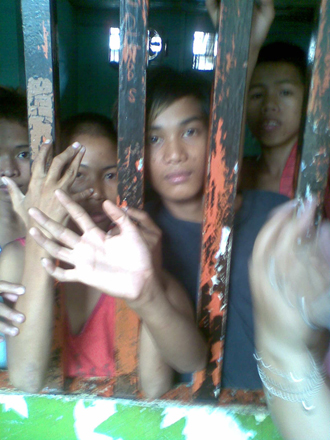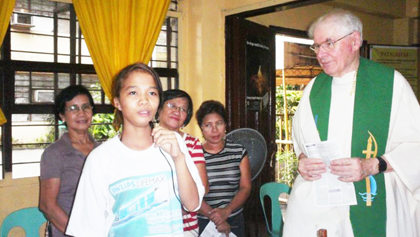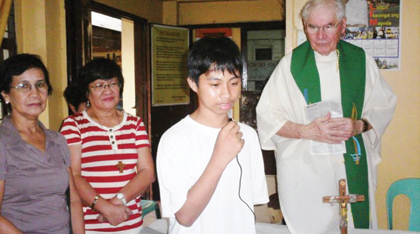Street Children Locked Up
By Fr John A. Keenan
Fr Keenan, from Ireland, is chaplain at Centro Escolar University Manila.
 Maria dela Cruz, 15, and Lourdes Garcia, 16, (not their real names) were abducted one night near their homes and taken to a detention center near Manila City Hall because of ‘bagansa’, vagrancy, ie, being out during curfew. Instead of being taken home to their parents they were dumped into an already overcrowded, poorly ventilated detention center called ‘Reception and Action Center’ (RAC). Most children do not know what curfew is and anyhow they do not have watches or know how to observe the curfew hours. The plight of such children abducted from the streets was highlighted a couple of years ago in the local and international media. It is estimated that there are up to 20,000 children behind bars in the Philippines.
Maria dela Cruz, 15, and Lourdes Garcia, 16, (not their real names) were abducted one night near their homes and taken to a detention center near Manila City Hall because of ‘bagansa’, vagrancy, ie, being out during curfew. Instead of being taken home to their parents they were dumped into an already overcrowded, poorly ventilated detention center called ‘Reception and Action Center’ (RAC). Most children do not know what curfew is and anyhow they do not have watches or know how to observe the curfew hours. The plight of such children abducted from the streets was highlighted a couple of years ago in the local and international media. It is estimated that there are up to 20,000 children behind bars in the Philippines.
In RAC some 70 children aged between 1 and 16 years are packed into three rooms barely big enough for 30. They have to sleep on the bare wooden floors side by side like sardines in stifling heat and poor ventilation. This center is run by the City of Manila and the Department of Social Welfare and Development. The main problem is over-crowding, lack of sufficient food, of clothing, of adequate facilities, of privacy and of staff.
In another building in the same compound some 170 children in trouble with the law - petty crime, stealing cell-phones, ear-rings, cash, and some charged with serious bodily crimes are held in six 'dormitories'. This building is called 'Manila Youth Reception Center’ and is run by the same authorities as the RAC. Again the problem is over-crowding: lacking furniture, bedding, privacy, ventilation, adequate recreation, reading materials and so on. The children have to sleep packed together like sardines. For many it is a place without hope as their cases may go on for months or years due to lack legal representation and due process. As minors, according to law they are supposed to be released from behind bars after eight hours and turned over to the Department of Social Welfare and Development (DSWD) for re-education, counselling etc.
A third section called ‘Lingap’ houses in a large tent displaced families, the destitute, the sick and dying, mentally ill, the old and abandoned. It reminds me very much of the homes run by Blessed Mother Teresa's Missionaries of Charity. Again, they lack trained staff, privacy, medical supplies etc.
The children are abducted by local officials in the local barangay and by the police. The children who come mainly from poor and deprived families, have been abducted for simply begging, selling goods, being alone even in broad daylight or just sleeping. Instead of taking them home they are impounded, irrespective of their rights to know why they are being abducted, the right of their parents to know about it and their right to know where they are being taken by complete strangers. For them it is a terrifying and traumatic experience. According to RA 9344, Section 21 regarding the procedure for taking a child into custody the arresting officer must, among other things, explain to the child a) the offence committed, b) identify himself to the child, c) refrain from slapping . . . or using vulgar words, d) avoid displaying weapons or handcuffs. Their parents or guardians must also be informed.
To compound their trauma, they are herded into sub-human conditions, small children along with big teenagers in an atmosphere of fear and trepidation. Such crammed conditions can spawn all kinds of abuse, introduction to vice and fights among themselves. They are only allowed out for half an hour’s recreation and for their meals three times a day. The rest of the time they are cooped up inside in the stifling heat. They have no opportunity for study or improving themselves. Sometimes they may be there for over a month or longer before being released by being sent to Boys/Girlstown, a children’s home or to their parents or guardians if they can be found. The resident staff do their best to help them and succeed admirably in many cases, but they are hampered by numbers.

The fact is that most of them should not be there in the first place since they are innocents, the victims of poverty, broken families and neglect both in the city and in the provinces. Instead of being ‘rescued’ they are being condemned to sub-human conditions. It has been suggested that the barangay officials and police are being rewarded for filling their quota of arrests. The Center is understaffed, there are not enough social workers to pursue their cases and set them free. They have an impossible job because of the lack of financial and personnel support. RAC is probably one of the better detention centers as compared with similar institutions in other cities in Metro Manila and in the provinces. If the community became more aware and helped poor families, paid just wages and made genuinely free education a reality, many of these children would not end up in RAC.
I celebrate Mass in RAC every Sunday morning, which is much appreciated by the children and staff. Before Mass the volunteers give the children religious instruction and I usually meet them individually. This gives me a chance to get to know them and their background. They are lovely children. As Don Bosco used to say, 'There in no such thing as a bad boy or girl'. They are simply victims of poverty, broken families, abusive parents, lack of a decent home, water, electricity, food, education. I feel pity for them and angry at Society, Government and Church, that are not doing more to respond to these basic human needs. Most have dropped out of school by 10 or so due to lack of food, 'pamasahe' (fares for public transport), requirements in what is supposed to be a free education for all. What hope is there for them? Without education or a livelihood will they end up as prostitutes, criminals and be shot at sight by the agents of an unjust society? It is very sad indeed.

The RAC staff, who are social workers, are very committed to the welfare of the children and do their best to feed and take care of them on a slim budget, until they find their parents or guardians. I feel that my presence there gives them spiritual and moral support in what could easily be a very depressing job. They are very welcoming and accommodating. Our work there complements what they are trying to do in convincing the children to avoid 'barkadas' (groups of peers, in this context with a negative connotation), vices and to go back to school.
Even more important and worthwhile is my ministry in Lingap to the destitute, the abandoned, the old, sick and dying, the wounded, the mentally sick, the street families etc. It is a microcosm of human misery and inequality under the shadow of an ultra-modern, luxurious shopping mall and Manila City Hall.
You may email the author at johnakeenan@yahoo.com
